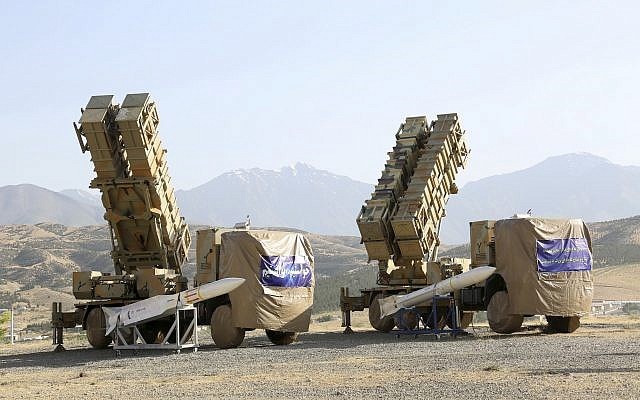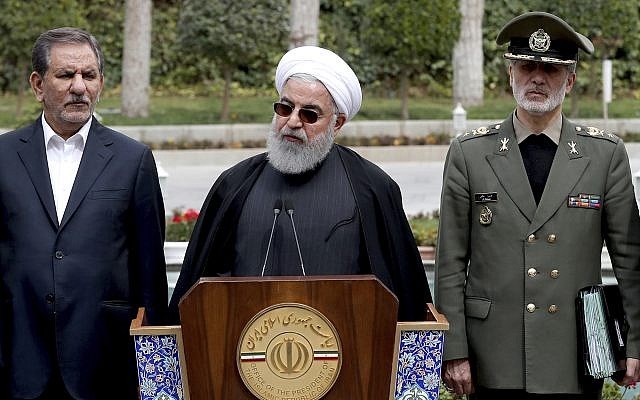
Monday June 10, 2019

This photo released by the official website of the Iranian Defense Ministry on Sunday, June 9, 2019, shows the Khordad 15, a new surface-to-air missile battery at an undisclosed location in Iran. The system uses locally made missiles that resemble the HAWK missiles that the U.S. once sold to the shah and later delivered to the Islamic Republic in the 1980s Iran-Contra scandal. (Iranian Defense Ministry via AP)
Islamic Republic’s defense minister says the Khordad 15 can trace targets 150 km away, intercept them at a range of 120 km and can destroy six objects at once
Iran unveiled a locally developed advanced missile defense system on Sunday that it says is capable of destroying fighter jets and enemy drones from as far as 120 kilometers (75 miles) away, state media reported.
The weapons system referred to as the “Khordad 15” was displayed in a ceremony attended by Iranian Defense Minister Amir Hatami in Tehran, during which he said that it could detect targets as far away as 150 kilometers (93 miles).
“It can also trace stealth targets in areas 85 km (53 miles) in distance, and destroy them at a distance of 45 km (28 miles),” the semi-official Fars news agency quoted Hatami as saying.
He added that the system is capable of destroying six targets simultaneously and can be set up for operation within five minutes.
The system uses locally made missiles that resemble the HAWK missiles that the US once sold to the shah and later delivered to the Islamic Republic in the 1980s Iran-Contra scandal.
The minister asserted that the Khordad 15 and other such systems were for use in defending Iran from foreign threats.
Iran has worked in recent years to build its own weapons locally, rather than relying on foreign actors. In February, the Islamic Republic said it had successfully fired a new long-range cruise missile, amid events marking 40 years since the 1979 Islamic Revolution.
The missile, dubbed Hoveyzeh, was described as a high-precision weapon capable of flying at low altitudes and able to carry a significant payload.
“The test of the Hoveizeh cruise missile was carried out successfully at a range of 1,200 kilometers (840 miles) and accurately hit the set target,” Hatami said then, quoted on state television which broadcast footage of its launch.
Iran’s ballistic missiles program (cruise missiles are in a different category) has been met with mounting concern in the West. Earlier this year, US Secretary of State Mike Pompeo accused Iran of testing a medium-range ballistic missile capable of “carrying multiple warheads,” which he said could strike “anywhere” in the Middle East and even parts of Europe.

President Hassan Rouhani, center, speaks during a media briefing after a cabinet meeting, as senior Vice President Eshaq Jahangiri, left, and Defense Minister Gen. Amir Hatami listen, in Tehran, Iran, March 18, 2019. (Iranian Presidency Office via AP)
Iranian efforts to establish a permanent military presence in Syria and attempts to transfer advanced munitions to the Lebanon-based Hezbollah terrorist group have led to hundreds of Israeli airstrikes in Syria in response to so-called “red line” violations. An Israeli satellite imagery analysis firm on Tuesday determined that the target of an airstrike on a Syrian air base earlier this week, which was attributed to Israel, appeared to be an Iranian drone facility.
Iran’s missile program was among the reasons cited by US President Donald Trump for leaving the 2015 nuclear deal last year and reimposing crippling sanctions. Last week Trump said he would be willing to reopen talks as long as Iran agreed to give up nuclear weapons.
Iran said Saturday that new US sanctions on its petrochemical industry show the hollowness of Trump’s claims to be open to fresh negotiations with Tehran.
AP contributed to this report.